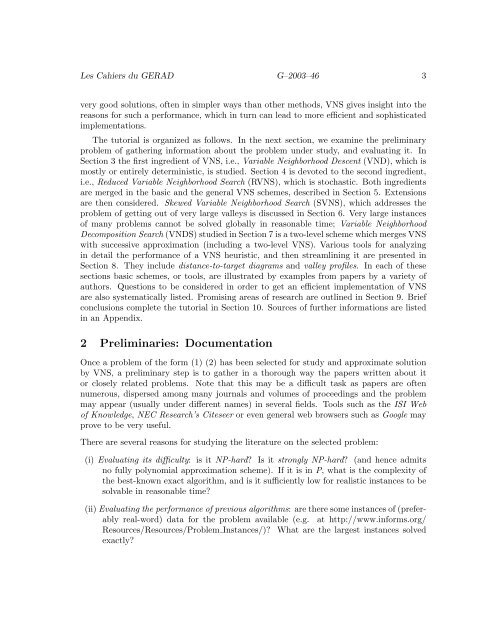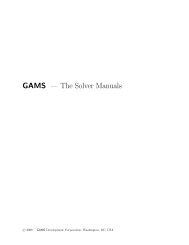A Tutorial on Variable Neighborhood Search
A Tutorial on Variable Neighborhood Search
A Tutorial on Variable Neighborhood Search
You also want an ePaper? Increase the reach of your titles
YUMPU automatically turns print PDFs into web optimized ePapers that Google loves.
Les Cahiers du GERAD G–2003–46 3<br />
very good soluti<strong>on</strong>s, often in simpler ways than other methods, VNS gives insight into the<br />
reas<strong>on</strong>s for such a performance, which in turn can lead to more efficient and sophisticated<br />
implementati<strong>on</strong>s.<br />
The tutorial is organized as follows. In the next secti<strong>on</strong>, we examine the preliminary<br />
problem of gathering informati<strong>on</strong> about the problem under study, and evaluating it. In<br />
Secti<strong>on</strong> 3 the first ingredient of VNS, i.e., <strong>Variable</strong> <strong>Neighborhood</strong> Descent (VND), which is<br />
mostly or entirely deterministic, is studied. Secti<strong>on</strong> 4 is devoted to the sec<strong>on</strong>d ingredient,<br />
i.e., Reduced <strong>Variable</strong> <strong>Neighborhood</strong> <strong>Search</strong> (RVNS), which is stochastic. Both ingredients<br />
are merged in the basic and the general VNS schemes, described in Secti<strong>on</strong> 5. Extensi<strong>on</strong>s<br />
are then c<strong>on</strong>sidered. Skewed <strong>Variable</strong> <strong>Neighborhood</strong> <strong>Search</strong> (SVNS), which addresses the<br />
problem of getting out of very large valleys is discussed in Secti<strong>on</strong> 6. Very large instances<br />
of many problems cannot be solved globally in reas<strong>on</strong>able time; <strong>Variable</strong> <strong>Neighborhood</strong><br />
Decompositi<strong>on</strong> <strong>Search</strong> (VNDS) studied in Secti<strong>on</strong> 7 is a two-level scheme which merges VNS<br />
with successive approximati<strong>on</strong> (including a two-level VNS). Various tools for analyzing<br />
in detail the performance of a VNS heuristic, and then streamlining it are presented in<br />
Secti<strong>on</strong> 8. They include distance-to-target diagrams and valley profiles. Ineachofthese<br />
secti<strong>on</strong>s basic schemes, or tools, are illustrated by examples from papers by a variety of<br />
authors. Questi<strong>on</strong>s to be c<strong>on</strong>sidered in order to get an efficient implementati<strong>on</strong> of VNS<br />
are also systematically listed. Promising areas of research are outlined in Secti<strong>on</strong> 9. Brief<br />
c<strong>on</strong>clusi<strong>on</strong>s complete the tutorial in Secti<strong>on</strong> 10. Sources of further informati<strong>on</strong>s are listed<br />
in an Appendix.<br />
2 Preliminaries: Documentati<strong>on</strong><br />
Once a problem of the form (1) (2) has been selected for study and approximate soluti<strong>on</strong><br />
by VNS, a preliminary step is to gather in a thorough way the papers written about it<br />
or closely related problems. Note that this may be a difficult task as papers are often<br />
numerous, dispersed am<strong>on</strong>g many journals and volumes of proceedings and the problem<br />
may appear (usually under different names) in several fields. Tools such as the ISI Web<br />
of Knowledge, NEC Research’s Citeseer or even general web browsers such as Google may<br />
prove to be very useful.<br />
There are several reas<strong>on</strong>s for studying the literature <strong>on</strong> the selected problem:<br />
(i) Evaluating its difficulty: is it NP-hard Is it str<strong>on</strong>gly NP-hard (and hence admits<br />
no fully polynomial approximati<strong>on</strong> scheme). If it is in P, what is the complexity of<br />
the best-known exact algorithm, and is it sufficiently low for realistic instances to be<br />
solvable in reas<strong>on</strong>able time<br />
(ii) Evaluating the performance of previous algorithms: are there some instances of (preferably<br />
real-word) data for the problem available (e.g. at http://www.informs.org/<br />
Resources/Resources/Problem Instances/) What are the largest instances solved<br />
exactly
















